
PREV ARTICLE
NEXT ARTICLE
FULL ISSUE
PREV FULL ISSUE
SELECTIONS FROM THE WEINBERG COLLECTION, PART 1Here's a selection of lots that caught my eye in the upcoming Heritage sale of the first part of the Alan V. Weinberg collection. There will be five or six sales in all of this 60-year collecting effort, with many items having been off the market for decades. -Editor Lot 4302: 1790 Standish Barry Threepence  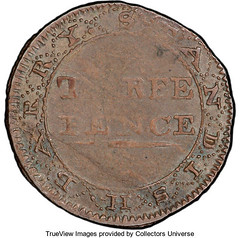 1790 Standish Barry Threepence, AU53 1790 3PENCE Standish Barry Threepence AU53 PCGS Secure. Breen-1019, W-8510, R.6. Ex: Seavey-Parmelee-Park-Weinberg. Die alignment: 0°. An exceptional example of this rare post-Colonial issue, of which perhaps two dozen are known. The peripheries are more firmly struck than the centers, and the strike is typically uneven. ALTIM of BALTIMORE is fairly weak, while the date -- uniquely expressed as JULY 4 90 -- is well-struck and TOWN is downright bold. The center portrait is about as clear as ever encountered on these pieces. The reverse center's THREE PENCE is weak, as almost always, but most of the peripheral legend is distinct, with some softness at the opening STA of Barry's given name. The planchet is slightly out of round, but the design elements and all legends are complete. This piece shows no evidence of the prominent die cracks visible on both sides of the magnificent MS64 example -- the finest known in private hands -- sold by us in January 2015 as part of the Donald G. Partrick collection. Standish Barry of Baltimore was one of two Maryland silversmiths to strike silver coinage in the years between the ending of the Revolutionary War and the establishment of the Mint at Philadelphia, John Chalmers having struck several types of silver coins in Annapolis in 1783. Both coinages saw extensive circulation, judging from the condition of surviving examples. Beyond the simple need to provide a circulating medium, however, the exact motivations behind the Barry threepence are uncertain. The unusually precise date has led to speculation that it may have been issued in commemoration of a local event, possibly held in honor of the signing of the Declaration of Independence, though Independence Day as such was inconsistently and mostly unofficially observed at the time. The obverse figure has also been the subject of much deliberation, with George Washington being the most commonly proposed identification, along with Standish Barry himself. In the Spring 2009 issue of the C4 Newsletter, however, Max B. Spiegel brought to light an 1843 article from the Baltimore Sun that named the figure depicted as James Calhoun, who was serving in a position analogous to Mayor in Baltimore on July 4, 1790. A comparison of contemporary portraits of Calhoun and the threepence's obverse figure strongly suggests that this attribution is accurate. Alan Weinberg's Commentary: One of the most difficult to acquire American colonial coins and the only such coin specifically dated July 4, 1790. Almost all of the surviving specimens are severely worn or holed and plugged. The few remaining are on irregular, short planchets with weak strikes at the reverse center and peripheral legends cut short. The desirability of this full flan, well-struck silver coin, so similar in size to the 1792 half disme, is reflected in its distinguished pedigree. Only one or two are considered superior, Ford's the finest. One of my favorite coins, pre-dating the 1792 patterns. Additional Commentary: This specimen was part of the extraordinary collection formed in the 19th century by Bostonian Lorin G. Parmelee. Building on an already remarkable cabinet, Parmelee developed it into one of the best ever by purchasing entire collections outright, skimming the handful of pieces needed, and selling the rest at auction. He did this with the George F. Seavey, J. Carson Brevoort, and Charles I. Bushnell collections, as well as with selections from the Sylvester S. Crosby collection. The present coin was from the Seavey cabinet, and was featured in the catalog of Parmelee's collection when it finally came to market in 1890. Listed on page 87 of the 2019 Guide Book. Ex: George F. Seavey Collection (1873), Descriptive Catalogue listing 188; Lorin G. Parmelee Collection (New York Coin & Stamp Co., 6/1890), lot 303; Laird U. Park Collection (Stack's, 5/1976), lot 21. Great coin with a great provenance. -Editor To read the complete lot description, see: Lot 4308: 1792 P1C Silver Center Cent 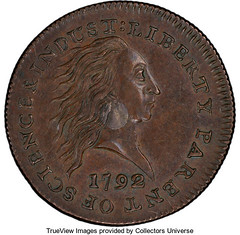  1792 Silver Center Cent, SP58+ Brown Rare, Historic Early Pattern, Judd-1 Warner-Winsor-Weinberg Specimen 1792 P1C Silver Center Cent, Judd-1, Pollock-1, Low R.7, SP58+ Brown PCGS Secure. CAC. Produced in the earliest days of the United States Mint, at a time when the monetary system of the country was just beginning to take shape, it is virtually impossible to overstate the importance of the 1792 Silver Center cent. With only 12 examples currently traced, it is among the rarest and most historically interesting issues in all of American coinage. Its distinctive bimetallic appearance is unlike any other early American coin and this piece is an especially pleasing example, with strongly impressed design elements and remarkably few abrasions. Heritage Auctions is privileged to present this iconic early pattern in just its fourth auction appearance since 1884. The 1792 Patterns The 1792 patterns are among the most valuable and important issues in all of American coinage. The first products of the United States Mint, these patterns represent the founding fathers' attempt to establish a useful and efficient monetary system for the new country. Based on specifications laid out in the Mint Act of 1792, the Silver Center cent, Fusible Alloy cent, Birch cent, half disme, disme, and Eagle on Globe quarter are the lineal ancestors of the coins we use in everyday life today, 226 years after their production. Although many of the designs were not ultimately adopted for regular coinage, the all-important concept of the decimal system, with the dollar as basic monetary unit, survives to the present day. The stability and durability of the U.S. monetary system can largely be attributed to the ingenuity and forward thinking embodied in these initial coinage efforts. The Silver Center Cent The Judd-1 Silver Center cent is arguably the most famous of the historic 1792 patterns. It was the nation's first bimetallic coin and the first documented striking of any coin within the confines of the First United States Mint. The Mint Act of 1792 specified the value of the cent as equivalent to 264 grains of copper, but it was felt that a copper coin of that size would be too unwieldy for practical use. The Silver Center cent was an effort to produce a coin with the intrinsic value of one cent in a more convenient, smaller size. The concept originated with famous patriot Thomas Paine, who outlined his thoughts on bimetallic coinage in a letter to then-Secretary of State Thomas Jefferson on September 28, 1790, a year and a half before the Mint Act was passed: "The metal convenient for a coin under the silver coin, should not differ more in its value from silver than silver does from gold-and if it differed still less it would be better; but as the relative values now stand, the difference increases where convenience requires it should decrease. But as no such a metal, which convenience requires, exists naturally, the question is whether it will answer to produce it by composition. The Present Coin The coin offered here first surfaced in the Thomas Warner Collection (S.H. & H. Chapman, 6/1884). The Chapman's notes on this coin in lot 3215 of the catalog provide a good description of the design and outline the contemporary knowledge about the issue: "1792. Cent. The Silver Centre. Head of Liberty, with flowing hair, facing r.; LIBERTY PARENT OF SCIENCE & INDUS.: 1792 under the bust. Rev. Laurel wreath, composed of two branches, tied by a ribbon, enclosing ONE CENT; outside of wreath, UNITED STATES OF AMERICA, the fraction 1/100 beneath the knot of the bow. A silver plug inserted in centre of planchet before the piece was struck, the idea being to give the value of the metal. Edge milled. Sharp, strong, even impression. Extremely fine. The finest of the five known. Of excessive rarity and a very valuable coin which should increase greatly in price before many years. The United States Mint collection does not contain one. Bushnell's sold for $120, and this is a sharper impression and lighter color. See Plate XII." The lot realized a strong price of $155, to coin dealer George Cogan, who may have been acting as an agent for someone else, or may have purchased the coin for inventory. In any case, the Chapman brothers handled the coin again a few years later, when they cataloged the collection of prominent numismatist Richard B. Winsor in December of 1895. The coin appeared in lot 291 of that sale: "1792 Silver Centre Cent. Bust of Liberty with flowing hair, facing right, beneath bust 1792: around, LIBERTY PARENT OF SCIENCE AND INDUST. R. Wreath of myrtle, enclosing ONE CENT; beneath bow 1/100; around UNITED STATES OF AMERICA. Borders and edge milled. Copper with silver plug inserted in the planchet before striking, so that now the silver bears its share of the impression and device - the idea being to have the value of the metal in the coin. Extremely fine. Light olive color. One of the finest examples of this excessively rare coin known. Probably not more than five exist. Cost $125. Plate. See Bushnell sale, No. 1766, sold for $120." The lot brought another strong price of $127.50, this time to well-known dealer Édouard Frossard. Frossard died in 1899 and it is possible that he held on to this piece until his death, as the coin vanished for almost a century after its appearance in the Winsor catalog. It must have been moving outside of numismatic channels until it surfaced again in lot 233 of the Loye Lauder Collection (William Doyle Galleries, 12/1983). Loye Lauder was a mysterious figure, who shunned publicity and kept her collecting activities very low key. Rumored to be an heir to the Estee Lauder cosmetics fortune, we have not been able to establish her relationship to that famous Hungarian-born entrepreneur. Our best information indicates she was born in 1911 and died in 1964, so she must have acquired her numismatic collection before the later date. This makes her collecting life more or less contemporaneous with that of Emery May Holden Norweb. These two women both built remarkable collections at a time when female collectors of Colonial and early American coins were almost as rare as the coins themselves. Lauder's collection was preserved intact by her estate for almost two decades after her death. Curiously, the collection was finally consigned to William Doyle Galleries, a firm that dealt mainly in antiques and had little experience with numismatic auctions. The timing of the sale was not ideal, as it took place three days after Stack's sold the remarkable Colonial collection of John Roper. Alan Weinberg had a strong interest in coins offered in both auctions. Unfortunately, he was unable to stay in New York long enough to attend both auctions himself, so he arranged for prominent dealer William Anton to represent him at the Lauder sale. Doyle Galleries conducted the sale in a manner more suited to an antiques auction than a numismatic event. In Alan's words, "Unbelievably, the format was a 'Dutch auction' - where the coin up for sale is offered at a high start price and, if no takers, keeps dropping until someone raises their arm." The 1792 Silver Center cent in lot 233 was initially offered at $70,000, the highest price Weinberg had authorized Anton to bid. Wisely, Anton refrained from bidding at that level and let the coin drop incrementally until it reached a $40,000 asking price. He judiciously placed his bid at that point, winning the lot, while other dealers looked on in astonishment. A week later, when the shock wore off, one of the dealers at the sale contacted Weinberg and offered him a $10,000 profit for the coin he won in this unorthodox fashion. Of course, he refused the offer. The coin has been a cornerstone of his remarkable collection for the intervening 35 years. Alan Weinberg's Commentary: One of the best acquisitions I've made in over 58 years of collecting. This coin was auctioned by Doyle Galleries, a New York City antique auction house, out of the Loye Lauder Collection. The sale took place less than a week after Stack's classic John Roper auction, which I attended in December of 1983. The Roper sale included another Judd-1 with a severe quarter-inch reverse planchet lamination missing, which sold for $18,000 to Tony Terranova. I could not stay in New York another five days, so I had my good friend Bill Anton represent me at the Doyle auction. Bill did not need a Judd-1, since he already owned the "Morris" coin. Little did Bill realize that his Morris coin had a questionable silver plug. Doyle's Lauder auction was a very peculiar "Dutch Auction" where they started the coin at $70,000 and worked their way down, with no one bidding and everyone sitting on their hands, to $40,000 before Bill raised his hand. Bam! The lot was immediately hammered closed, at half the catalog estimate. Jaws dropped throughout the auction room. A week later, I received a call from a prominent dealer who attended the auction offering me a $10,000 profit for the coin. I declined. I consider this coin the third-finest known, after the Garrett and Norweb examples. In some respects, it is even finer than the Norweb example, as that piece has a defect in the field at Liberty's forehead and a slight planchet clip at 10 o'clock that is now concealed by the holder. A collection centerpiece! -Editor To read the complete lot description, see: Lot 4310: 1792 Birch Cent, Plain Edge 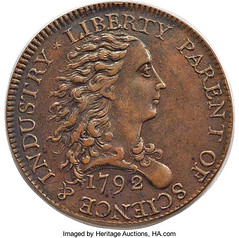 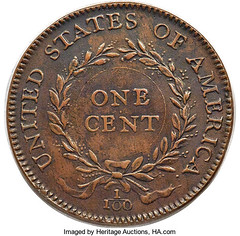 1792 Judd-3 Birch Cent Electrotype Made from the Appleton Specimen 1792 Birch Cent, Plain Edge, Judd-3, Pollock-4, AU. 224 grains, 33 mm. The Birch cent ranks among the most famous 1792 pattern coin designs and is highly popular with the few collectors who are fortunate to own an example. There are four Judd numbers of two different designs of Birch cents. Judd-3, 4, and 5 differ in edge inscription, and Judd-6 has a different reverse design. Just 14 Birch cents survive of all four varieties, and two of those are in museums. We believe that this piece was made from the Appleton specimen of Judd-3, although the authors of 1792: Birth of a Nation's Coinage write: "It is difficult to identify the host coin for many electrotypes made from [these] pieces." Both sides are slightly wavy, not unusual for these electrotypes. The surfaces are glossy chocolate-brown with traces of orange in the protected areas. A glass reveals slightly pebbly surfaces. Overall, a highly attractive example with subtle file marks masking the seam on the edge, and no evidence of lead showing anywhere. Alan Weinberg's Commentary: From Maurice Gould's Boston estate. The finest Birch cent electrotype I've ever seen. The few others are pebbly, with uneven wavy surfaces. This is simply superb and, as I couldn't afford the genuine Birch cent, let alone the rare opportunity to acquire one, I acquired this. I was present at the Johns Hopkins / Garrett, Part IV auction wherein there was the Gem copper Birch cent and the unique white metal Birch cent from different dies. The first to Don Partrick and the second to Bill Anton at less than half the price of the copper example. Ever the clever bargainer, Bill confided in me right after the sale that he and Partrick divided up the Birch cents beforehand so as to save each other money. Obviously, Bill got way the better deal. Ex: Maurice Gould. Numismatic history in your hands. -Editor To read the complete lot description, see: Lot 4323: 1792-Dated CENT Circa 1859 Dickeson Restrike Token   1850s Dickeson Token, Eagle on Half Shield Design Judd-C1792-1, MS64 Red and Brown 1792-Dated CENT Circa 1859 Dickeson Restrike Token, Breen-1380, Judd-C1792-1, MS64 Red and Brown PCGS Secure. Ex: Weinberg. The proper description of the die is an Eagle Standing on a Half Shield. Nineteenth century numismatist Montroville Dickeson created this token around 1859. Upon acquiring the two dies and noticing a similarity to the 1792 Eagle-on-Globe pattern design, Dickeson concluded that these dies must have been intended for 1792 pattern coins as well. The authors of 1792: Birth of a Nation's Coinage discuss the Dickeson pieces in that reference. They include a census of examples known to them, recording just two dozen pieces. Six of those are in museums. These pieces are substantially rarer than generally believed. The Weinberg specimen is stunning. The surfaces are prooflike with considerable mint red color and lovely blue overtones. A few old spots are evident. Overall, an impressive example of this prized piece. Alan Weinberg's Commentary: The fascinating "1792" Dickeson patterns were apparently struck in two batches at separate times in 1859 or 1860. This is one of the few Prooflike specimens known with almost "watery" fields and considerable original color. Most often this beautiful coin is found with non-reflective, satiny, dark brown surfaces. I did feel this "pattern" was so aesthetically pleasing and attractive that it belonged in a 1792 U.S. pattern collection, as did Woodin, Pollock and the three authors of the new 1792 coinage reference. A real beauty. -Editor To read the complete lot description, see: Lot 4318: 1793 1C Wreath, Lettered Edge  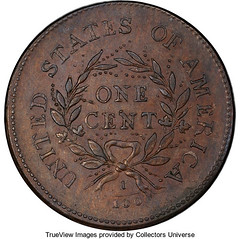 1793 S-11c, B-16c Wreath Cent, AU55+ Lettered Edge Ex: Davis-Naftzger 1793 1C Wreath, Lettered Edge, S-11c, B-16c, Low R.3, AU55+ PCGS Secure. Ex: Clarke-Naftzger-Weinberg. The mixture of die states of the two Lettered Edge types for S-11 proves that the edge devices were placed on the coins first, and then they were struck in a separate operation. All examples of the S-11a Vine and Bars edge subvariety are in the earliest die state, while S-11b and S-11c are known in all of the four die states described in the Breen Large Cent Encyclopedia. After appearing for sale in the January 1890 New York Coin & Stamp Company sale of the R. Coulton Davis collection, this piece was off the market until super-collector Ted Naftzger included it in the New Netherlands sale of his duplicate coins in 1973. The cataloger for New York Stamp & Coin wrote: "1793 Wreath: same dies as last, but edge inscribed ONE HUNDRED FOR A DOLLAR: sharp, clear impression, slightly chafed on highest locks of hair, well centered: light olive color: very fine and desirable." The New Netherlands cataloger in 1973 provided more detail: "1793. S-11c (R-3). C. 11-J. Wreath. Lettered edge, single leaf after dollar. About Uncirculated-55. Natural light olive and medium brown even color, but with a much smoother surface than the last. Struck evenly on the obv., while the rev. is struck slightly off center towards twelve o'clock. Formerly thought to be finest and closely challenged by several others, but the Brand collection produced a clear finest known Mint State-60 specimen. One of the best lettered edge cents we have seen and been privileged to sell." Alan Weinberg's commentary: Nice light brown and one of the three or four finest specimens known. I bought this slabbed from Jim McGuigan, consigned by Denis Loring, only on condition I could break it out of its old slab first to examine the rims as I dislike rim bumps. Jim agreed so long as I would agree to pay the re-slabbing fees if I disliked the rims. Viola! The rims were immaculate. Thanks Jim! The Weinberg Specimen. Breen Die State I, with no visible clash marks on either side. Splendid and fully natural light olive and medium brown with splashes of mahogany patina on each side. A trace of wear is evident on the highest hair locks. Bill Noyes and Del Bland each assign a conservative grade of XF45, and they agree that this piece is tied for the sixth finest S-11c Wreath cent. Ex: Robert Coulton Davis (New York Coin & Stamp Co., 1/1890), lot 2511; S.H. & H. Chapman; later, Dr. William H. Sheldon; T. James Clarke (10/1954); R.E. Naftzger, Jr. (New Netherlands, 11/1973), lot 334; R.E. Naftzger, Jr.; Michael Elliott; Bruce Stowe (10/1995); Thomas D. Reynolds (2/1997); Denis W. Loring; via Jim McGuigan. Fabulous coin with another excellent provenance. The consignor comments are a nice feature. It's transparent, and adds color that a cataloger can't necessarily provide. I like it. -Editor To read the complete lot description, see: 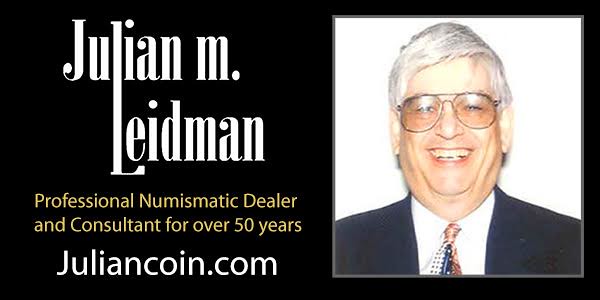 Wayne Homren, Editor The Numismatic Bibliomania Society is a non-profit organization promoting numismatic literature. See our web site at coinbooks.org. To submit items for publication in The E-Sylum, write to the Editor at this address: whomren@gmail.com To subscribe go to: https://my.binhost.com/lists/listinfo/esylum All Rights Reserved. NBS Home Page Contact the NBS webmaster 
|